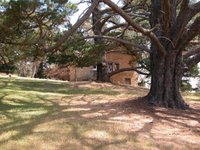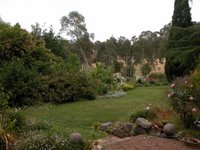I have always been a huge admirer of his landscape paintings and wasn’t really aware of his other works until I made this trip. His oil Still Life paintings just blew me away. He stopped painting these when his daughter Nora took up Still Life painting, presumably for their work not to be compared. Hans’s graphite and charcoal drawings are something that I can only ever hope to aspire too. They are rendered by a true master.
The Heysen’s family home was purchased in 1912 where he remained until his death in 1968 at the age of 90. Hans and his wife Sallie had eight children. “The Cedars” as his home was named, had extensions added to it as his family increased.
While the tour was being conducted we were told that photos were not allowed to be taken inside the house. The house is like walking back into time. One lady that traveled on the same bus as me asked do I feel something about the room that we were in. I knew straight away what she meant with a spiritual feeling permeating me as if there was a tangible presence to the whole house. It was partially noticeable in the master bedroom where more than one birth and death had occurred. The strong sense of history was very real in this home. This probably comes from the many Paintings, drawings, prints and books that remain on view along with the solid wood furniture and Persian rugs scatter throughout the house.
Before I move on there is a Still Life called Zinnias and Autumn Fruit that I viewed over the mantle piece. This work Hans painted is nearly as wide as the large chimney that it hangs on. The painting was never for sale as it was a gift to his wife. Anna Pavlova, a visiting Russian Ballet dancer saw this painting and offered Hans a blank cheque for it. Anna was quite insistent that she buy the painting and “put out” that Hans would not sell her this painting. He offered to paint her a similar still-life though not an exact copy, which he did. When the painting was delivered to the Russian dancer she returned it saying that if she couldn’t have the painting that she wanted she would have no painting at all. That painting Anna didn’t want was soon purchased by another buyer and became one of Hans best.
Hans studio also had the same feel as the house though with a much more open airy sense due to the massive glass window at the end of his studio. The enormous window was imported from overseas and traveled from Adelaide by horse and cart, which would have been a feat on it own but did arrive safely. The glass has a frosted look about it so that there was a defused light into the studio. The studio was left as if Hans himself had just finished a day of painting. You can see by the wear on the large Persian rug where Hans worked in two areas at his larger than life easel by moving it into a different position as the light moved. Once more photos could not be taken but do regret not taking a photo of the window from outside.
At the time of his death it was instructed by Hans himself that all unsigned works were to be burnt. His family respected that and the big burn did happen, which in same ways saddened me as so much history literally went up in smoke.
The surrounding gardens are a delight to investigate. Hans never farmed his property; instead he planted his beloved gum trees throughout the land. This property still remains in the care of his family.
Even though the day was overcast and drizzly, I was please to get the opportunity to take a few photos in and around the Heysen grounds.

The Heysen Home

Studio

Car Shed


![]() technorati tags: Hans Heysen, artist, history
technorati tags: Hans Heysen, artist, history
No comments:
Post a Comment